This essay was published in the Journal of the Moscow Patriarchate in 1993, just after the Soviet regime had fallen, but Church life had not been fully restored. Some of the monasteries mentioned here have already made progress in their restoration, but the general picture is roughly the same today as it was when the author made his contemplative pilgrimage to these once glorious monasteries along northern Russia's Obnora River.
On this Sunday when we commemorate all the saints who shorn forth in the Russian land, we present this essay on the monastic legacy of these disciples of St. Sergius of Radonezh, the “Abbot of all Russia”.
* * *
Old Russian monasticism was a clear manifestation of the morality of Russian secular society: the yearning for departure from the secular world was growing along with the rise of moral standards and not because of increasing calamities. It means that Russian monasticism was renouncing the world for the sake of ideals too high for it, and not for the sake of principles hostile to it.
—V. Klyuchevsky
The Obnora River. St. Sylvester and the Holy Resurrection Monastery.
On the very border of the Yaroslavl
and Vologda regions there is the village of
Sloboda—one of the many similar wretched
villages of the Russian provinces. Everlasting
quietness reigns there, although only two versts away
roaring trucks are rushing by on the Arkhangelsk
highway day and night. Sad log huts are facing the
only village track beaten by tractors. Just from
the center of this main street a glade leads to the
forest. One could leave it completely unnoticed
or take it for a rut leading to a farm if it were not
for a rusty plate with an unexpectedly high-sounding
title— "The Obnora Road".
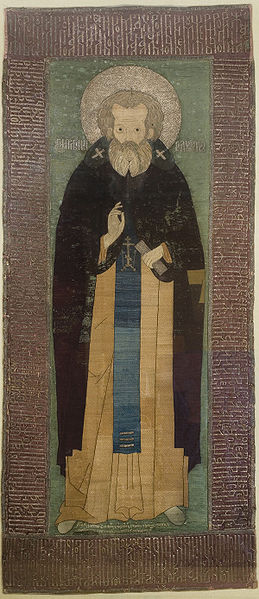
Covering embroidered in for the relics of St. Sylvester of Obnora. Circa 1664. Ermitage Museum.
Once smooth and busy, the road was abandoned long ago. A two to three hours' walk through the forest among glades overgrown with small birches, through the marshland covered with mounds, with myriads of gnats swarming over it—and you will see a meager ploughed field taken over from the forest that lies ahead, just beyond the bend. The huts on either side of the village look very friendly in the shadow of a dense birch grove. A little further on, one suddenly sees the dark-blue valley of a river. It is the Obnora, the right tributary of the Kostroma River—one of the main water ways of monastic Holy Russia’. In olden times it served as a kind of a thread made through the toils and prayers of fearless recluses into a necklace of hermitages and monasteries. It could be rightfully called a holy river.
Monk Sylvester was the first to come to the Obnora River. With time he was canonized for his saintly way of life and purity of soul. Like all pioneers, Monk Sylvester became a rather legendary person. Neither his Life nor even the dates of his birth and repose have been preserved. Some consider him to be a contemporary of St. Sergius of Radonezh, who is often called the “Abbot of the Russia land”, others think he was a contemporary of Monk Gerasim, whose name is connected with the earliest records of the town of Vologda (1147). Monk Sylvester as if hovers over time, having no firm connection with any particular epoch. One can say with certainty only that he was a man who yearned for silence. According to the Life of St. Sergius of Radonezh, having once experienced the "sweetness of silence" St. Sergius could never forget its taste. St. Sylvester experienced the same spiritual thirst. Having hidden in one of the remotest corners of the deep Obnora forest he erected a cross on the steep bank, made a log hut which served as his cell, and began to live between the sky and the river in complete solitude, not fearing the surrounding forest and its inhabitants. “He who has become the servant of God fears his Lord alone; and he who has no fear of the Lord is often afraid of his own shadow”, said the favorite teacher of Russian monks, the early Christian zealot, St. John Climacus. “It is not the wilderness and the gloom of the place that strengthens the devils in their fight against us, but the barrenness of our souls.” St. Sylvester must have recalled these words in his hour of trial.
Time went by. People started coming to the zealot living on the bank of the Obnora River. Some were seeking his advice and blessing, others wanted to become his co-strugglers.
As a true recluse who has taken a vow of silence, St. Sylvester directed all his thoughts to the image of Jesus Christ. The words of the Savior, Him that cometh to me I will in no wise cast out (Jn. 6:37) were a law for him, and he welcomed everyone seeking to labor for salvation alongside him. Soon a small monastic community formed. A wooden church arose on the bank, dedicated to the “Feast of feasts”—the Resurrection of Christ.
But having performed his duty to the brethren and organized the life in the monastery, St. Sylvester did not find the peace he desired. Feeling constant thirst for silence, he often left the monastery to live alone in the deep forest. Not just an outward, physical state, but as an inward peace as well, this silence helped him fulfill one of the principle callings of the zealots of old, to harken to the voice of one's own soul, which is drowned out by the noise of the passions and vanities of the world. "Let us listen to ourselves", said St. John Climacus. This exhortation time and again repeated by other fathers of Christian monasticism was like a key to a door that opens into a world of pure, spiritual joy and bliss, springing from a sense of nearness to God, of communion with Him.
“The Russian monastery was always with the people”, said Elder Zosima, a character from Dostoyevsky's Brothers Karamazov. Monasteries were a necessary element of society. Besides their main aim—prayer for the salvation of the soul and for the good estate of Russia and its people, a monastic community satisfied many other everyday needs of people living in the secular world. The monastery was a school and a charity distributor, an almshouse and a hostel, a hospital and a cemetery, a home for mental patients and food reserve for times of emergency. This role of monasteries was especially strong in the forest region by the Volga River and in the Russian North.
Quite often peasant communities
founded new monasteries. Of course the relations
between some monasteries and communities were not
always unclouded. Once monasteries had become firmly
established, they began to possess land along with
serfs. The amount of land holdings at times
caused indignation among the peasantry. However, one
should not overstate the role of such resentments
within a well-adjusted system that existed for
centuries, the basis of which was mutual
interest.
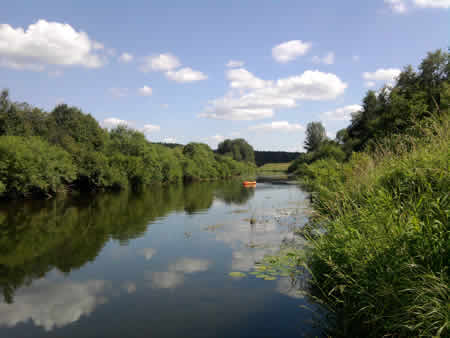
The Obnora River.
Satisfying numerous everyday needs of society, the monastery, as far as it could, healed its spiritual ailments as well. The wise elder and recluse blessing a brave Russian knight to go forth to his heroic deeds is not just a character created by Pushkin. He has a real prototype.
Like other famous zealots of Old Russia, St. Sylvester would leave his forest cell from time to time and talk to people who came from all around. “Offer visitors what they need for the soul and body”, St. John Climacus taught. No Russian saint ignored this exhortation.
After the repose of St. Sylvester, like a thin but deeply rooted sprout the small monastery founded by him survived hard times. It was ravaged by the Kazan Tatars during their terrible raid of the Kostroma region in 1538, and burnt down by the Poles during the Time of Troubles. Nevertheless it withstood all this, reviving from ashes and ruins. The main shrine of the monastery—the grave of St. Sylvester, attracted all those seeking spiritual life. A chapel was built over the tomb, where many miraculous healings occurred, and where the grace-filled strength of the man of God was revealed.
The first tsars of the Romanov Dynasty were well known for their piety and care for monasteries. This care was not due to their merits alone; it was characteristic of society at the time. The dramatic events of early 17th century—the end of the dynasty, foreign invasions, the break-up of the state and its painful restoration—all this made people feel like grains of sand on the palm of the Almighty. The bright and exuberantly patterned decoration of churches of that epoch vividly expresses this common joy of the miraculous resurrection from the dead, of the grace of God regained by the land of Russia.
The monastery on the Obnora River was not forgotten by the tsar. The Church of the Resurrection of Christ was renewed and newly consecrated; above the tomb of the monastery’s founder a Church dedicated to the Protecting Veil was built. In 1675 one more church, this time a stone one, appeared in the monastery—the Church of the Meeting of the Lord.
But in no other country in the world was construction so closely connected with pitiless and reckless destruction as it was in Russia. The reforms of Peter the Great were accompanied by severe measures aimed at the reduction of the number of monks. However, the hardest trial for Holy Russia became the secularization of church lands by Catherine II in 1764. Numerous smaller monasteries were liquidated in the course of this action, their churches being handed over to parishes. The Monastery of St. Sylvester did not avoid the common lot either: abandoned churches became dilapidated, and the brethren dispersed in grief. In 1825, in place of the old wooden Church of the Protecting Veil a stone Church of the Resurrection of Christ was erected. All the main shrines of the monastery, including St. Sylvester's cell icon, were transferred there. The relics of the saint also repose in the church, and many stories have been told about appearances of the saint and miracles worked by him. In his sketch of 1866, Father Peter Sokolov tried to reproduce the reverent atmosphere of constant expectation of a miracle that surrounded the seemingly ordinary provincial church.
Very long ago, the bells of the Resurrection Church rang their last. Church plate and shrines were plundered and the half-ruined church itself serves as a shop. But the solemn surroundings of the place fascinate and inspire as before. And the same picture of mysterious Russia in all its severe greatness, covered with forests, opens to one's gaze from the steep bank of the Obnora...
The Monastery of the Transfiguration of the Savior. St. Gennadius.
In the course of the reform of 1764,
five small monasteries were closed down on the Obnora
River. The only monastery that survived the hard
times was St. Gennadius's Monastery of the
Transfiguration of the Savior. One can get there by a
local bus from Lyubim, the smallest town in the
Yaroslavl Region, to the village of Obnorskoye.
Lyubim was built around a fortress erected in the
early 16th century to protect the region from the
sudden raids of the Kazan Tatars. From the village of
Obnorskoye and the near-by village of Pavlovskoye the
path leads along the left bank of the river to the
crossing. On the opposite bank there is a village of
Pochinok. Boatmen living there help people across the
river, although in a hot summer one can wade it. St.
Gennadius's Monastery of the Transfiguration is
located three kilometers away from the village of
Pochinok, at the edge of the village of Sloboda. The
distance does not seem long: the road passes through
a pine forest, stately and beautiful all year
round.

St. Gennadius. Icon painted in 1900.
At last we reach the village of Sloboda, beautiful, with its huts richly decorated with wood carving. Half-ruined buildings of a monastery can be seen on a hill among gigantic poplars and lime-trees, perhaps remembering, the time of Peter the Great. History itself lives in this remote corner of Russia.
The monastery was founded by Monk Cornelius of Komel. St. Cornelius was a man who yearned all his life for spiritual labors, asceticism and fraternal, evangelic relations between people. Having departed from the monastery he had founded on the Urma River and wandering a long time, he settled together with his disciple Gennadius at the estuary of the Obnora. However, very soon Grand Prince Vasily III himself demanded that Cornelius return to the monastery he had founded, for without him it began to decline. The monk fulfilled the will of the sovereign. He left his disciple Gennadius at the new site on the Obnora River.
The disciple turned out to be worthy of his teacher. A small monastic community was formed there. The brethren alternated between common and cell prayers and all kinds of labor in the monastery.
Many times Abbot Gennadius left for Moscow to solve monastery problems. Being once on a visit to boyar Roman Zakharyin, as the story goes, he foretold that the boyar's daughter Anastasia would become the wife of a Tsar of All Russia. This prophecy came true in 1547, and in 1548-1550 the monastery received generous donations from Tsar Ivan IV. Later on, the tsar asked his favorite abbot to become the godfather of his children.
Twice the Cathedral of the Transfiguration of the Savior was burnt to the ground, the last time being in 1639. In 1644-1647, a brick cathedral was erected in its place. It has survived up to our days, though it suffered a great damage under Communist rule. At first it was intentionally destroyed, bricks being taken out for personal needs, then the half-ruined church was left to the snow, rain and wind to accomplish what people had not done. But by a miracle the cathedral still exists. A rare visitor having made his way through the thickets of burdock and nettles enters under its vault with yawning breaks scaring away a sleeping owl. And, as it often happens in Russia, amidst the "abomination of desolation" a heavenly sky-blue opens suddenly. Rains gradually washed away the layer of the rather cold and pretentious nineteenth century wall-paintings to reveal the harmonious lines of the old frescoes. These patches of sacred art are especially dear to one's eye and soul on the background of the naked brickwork.
According
to the monastery’s ancient chronicle, there
used to be a side-altar in the southern part of the
cathedral dedicated to St. Sergius of Radonezh, for
whom the elders had a great veneration. The tomb of
St. Gennadius, founder of the monastery, was also in
that side altar. In 1751, not far from the cathedral
a stone church in honor of St. Alexis the Man of God,
the patron saint of Tsar Aleksey Mikhailovich
(1645-1676), was erected in place of the wooden
one.
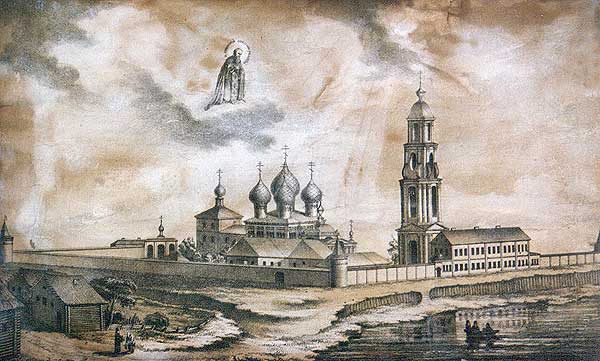
The Holy Transfiguration St. Gennadius Monastery. 19th c. lithograph.
The monastery belfry (1715) looks today like a gigantic, clumsy column. The blame for this is not to be placed on the barbarians of this century alone. In the early 19th century, a destructive wave of "pious renovations" rolled through the Russian monasteries. It was then that the father superior of the monastery took a strange decision to turn a traditional belfry into a classical one, adding two more tiers to it.
A
sturdily built wooden monastery guesthouse still
stands in this sad, desolate place near the Holy
Gate. Long ruined, it is a lonely witness of the
former good state. Today one can only imagine what
the monastery used to look like in the past. It was
surrounded by a stone wall with towers. To the
north-west of the cathedral was situated a wooden
abbatial residence built in 1774, with a spacious
basement for food supplies under it. To the west of
the cathedral, a long two-storey building for the
brethren stood along the wall. The first floor housed
a refectory and a kitchen, and the ground one—a
bakery, a workshop, and storage rooms. There was a
well nearby.
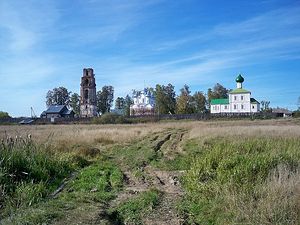
The St. Gennadius Monastery today.
Outside the monastery walls, behind the ponds dug in Abbot Gennadius's time, there were a bathhouse and a stable. The monastery had a large orchard and a kitchen-garden. In the 18th century until 1764, the labor of monastery peasants, numbering 1376 men, was widely used in the monastery; later, the brethren counted mainly on themselves. But Russian monks have always considered manual labor to be useful and necessary both physically and spiritually. This attitude towards labor is sanctified by the Apostle who said: If anyone will not work, neither shall he eat (2 Thes. 3:10) and supported by the examples of such great toilers as St. Theodosius of the Kiev Caves and St. Sergius of Radonezh. Monks could both organize their economy and work well.
The Monastery of the Savior. St. Sergius of Nurma.
The
Obnora River is the confluence of two minor
rivers—the Nurma and the Velikusha. There were
several old monasteries on the Nurma River as
well. One of them was located in the village of
Spas-Nurma, the only memory of which is now a parish
church built in the late 18th century in place of the
wooden monastery church. The founder of this
monastery, St. Sergius of Nurma, was of Greek origin.
He came to Russia from Mt. Athos and settled in the
Holy Trinity Lavra during the time of St. Sergius of
Radonezh. With time he felt a thirst for the hardest
of monastic labors—the life of a
hermit—and retired to the severe Obnora
forests. How did the monk from the Holy Mountain,
unaccustomed to Russian frosts, survive there, deep
in the woods, among bottomless marshes? "An
Angel aids him who has taken the vow of
silence." Monk Sergius erected a cross and built
himself a log hut for a cell on a hill on the bank of
the Nurma, in a heavenly place, where the earth
itself as if reaches out for the sky, where one
recalls the words by St. John Climacus: "We can
take clear directions for spiritual life from what we
observe in nature".
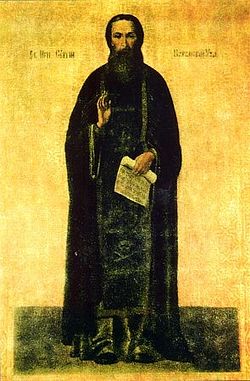
St. Sergius of Nurma.
The
small Monastery of Savior of St. Sergius of the Nurma
existed for several centuries, then fell victim to
the 1764 church reforms. It is no more. However, the
church erected in its place is a reminder of the
spiritual light disseminated throughout Russia by the
disciples of the Abbot of the land of Russia. St.
Sergius of Radonezh. Traditional in form, with later
imperfect annexes, the church nevertheless has its
grace and gives one a feeling of a flight. A massive
two-storey building has practically no exterior
decoration and looks almost stern, as becomes a
monastery. However, the architectural form of
the upper part of the building adds to it a light and
pure tone. Fragile in appearance, the little domes
carry big, open-work crosses. A graceful steeple
rises high into the sky.

The Monastery of St. Sergius of Nurma today. Photo: Peremeny.ru.
Only fragments of frescoes have been preserved inside the ravaged church. However, at one time it was richly decorated, and sacred articles were kept in it: the staff that St. Sergius of the Nurma used when travelling, the manuscript of his Life from 1584, old icons and books. The tomb of the saint, a splendid reliquary under a canopy, was also there.
Standing at the door of the church one can see a river valley stretching many versts, dark forests and glades, green and yellow strips of ploughed fields, groups of huts on the hills. There is a certain peculiarity in this picture, familiar and dear to every Russian heart: soft and lyrical colors of the central Russian landscape imperceptibly mix here with gloomy shades of the northern taiga.
The Holy Trinity Monastery. St. Paul of Obnora.
In
less than an hour a winding riverside path from the
St. Sergius of the Nurma Monastery of the Savior up
the river leads us to the former Monastery of St.
Paul of Obnora. Like St. Sergius of the Nurma, St.
Paul of Obnora was a disciple of St. Sergius of
Radonezh, called the “great elder” by his
contemporaries. Having blessed Monk Paul he gave him
a cross—the strongest weapon in the world.
Paul, as poor as Job and as light-hearted as a lark,
began his travels to monasteries and hermitages of
the Volga Region. He met and talked with the
likeminded monks—St. Avraamy of Galich and St.
Sergius of the Nurma. The latter advised him to
settle on the banks of the Nurma. There, in a marshy
low place, Paul one day saw a column of fire—a
divine sign. From the practical point of view, it was
not the best place for a monastery. But could such a
trifle stop a zealot who had been living for three
years in a hollow of a huge linden tree trunk?
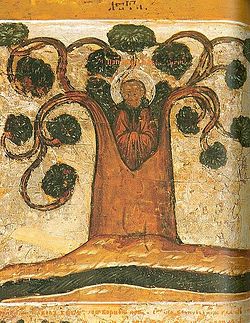
St. Paul of Obnora living in a linden tree. 17th c.
In 1414, Monk Paul received a blessing from Metropolitan Photius for the founding of a monastery. Its main church was dedicated to the Holy Trinity—the image dearest of all to St. Sergius of Radonezh and the heavenly prototype of ideal relations between people. By the end of his life, Abbot Paul handed the administration of the monastery over to one of his disciples and retired to a secluded place in the forest on the steep right bank of the Nurma to live in a cell. There he acquired the peace that he lost in everyday care for the community; there he again experienced an inexpressible joy, for only "the ear of the one who has taken the vow of silence will receive divine revelation from God".
The Monastery of St. Paul was to become the biggest monastery of the region. In 1505-1516 a stone Trinity Cathedral was erected there. Only old sketches and photographs keep the memory of it: the old church under the vault of which tsars Vasily III and Ivan IV had offered up their prayers was mercilessly destroyed in 1936. Its bricks were used to lay the village road to the Vologda highway. St. Dionisius, a great icon-painter of Russia of the Middle Ages, had worked in the monastery cathedral, and many precious works of ecclesiastical art were kept there, some of them now part of the Vologda museum collection.
The cathedral was the first but not the only stone building in the monastery. In 1547, after the All-Russia canonization of Paul of Obnora a wooden side-chapel dedicated to St. Sergius of Radonezh was built over his tomb. On the tomb lay the cross with which the great elder had blessed his disciple.
In 1586, thirty years of construction of a refectory building that has survived to our days was over. Money sent by Tsar Ivan the Terrible not long before his death helped finish it. In the repentant moments of his final days, the tsar ordered the brethren to remember in their prayers the innocent victims of his evil deeds.
The old refectory has grown into the earth and is surrounded with annexes. Its uneven half-meter thick walls cut with narrow windows breathe age-long peace. Its interior is a sad picture of desolation. The children's sanatorium that occupied it during Communist times has abandoned the old monastery buildings, and a new resident has not yet been found; and will he ever be found?
The refectory used to be an important part of the life of the monastery. Common meals were one of the basic principles of equality among the brethren. "They should all enter the refectory and eat together", says the old Studite Rule adopted in Russian cenobitic monasteries since the time of St. Theodosius of the Kiev Caves. The life of a monastic community is like a clock mechanism, set to motion by an invisible hand of the Almighty. Days, weeks, months and years passed by unnoticed in the daily cycle of services and obediences. Like every action of a monk, the meal began with a prayer. After Liturgy, having received the blessing and heard three strikes of the bell, the brethren processed in line to the refectory. According to the rule, the procession was headed by the priest who had conducted the divine service on that day, and the abbot. The brethren sang psalm 145I will praise the Lord in my life. The Lord shall be king unto eternity; thy God, O Sion, unto generation unto generation.According to the rule there was a specific order to the meal. It started with thanksgiving to the Lord for the daily bread, was accompanied by the reading of the Lives of Saints, and ended with a distribution of bread among the beggars at the monastery gate.
Besides the refectory and the father superior's residence (16th century) adjoining it from the west, two two-storey buildings for the brethren still exist in St. Paul's Monastery. One of them was built in the middle of the 17th century, another one, approximately a hundred years later.
The 18th century was a hard time for
all Russian monasteries and for St. Paul's Monastery
in particular. As a result of the confiscation of
church lands in 1764, the monastery lost nearly 2,000
peasants. A fire in the monastery in 1764 made the
life of the brethren ever harder. This is how
Archimandrite Pachomius, a new father superior,
described the condition of the monastery in 1771:
“The Monastery of St. Paul appeared to be very
dilapidated; the walls are ruined, cells are rotten
through and both the abbot and the brethren have no
place to live; roofs of churches are leaking, stone
buildings are decrepit and it is dangerous to conduct
divine services in the cathedral church.” At
last, in 1777, repair works in the monastery
buildings were carried out. However, over the
following hundred years the state treasury expenses
on the needs of the monastery were very scant.
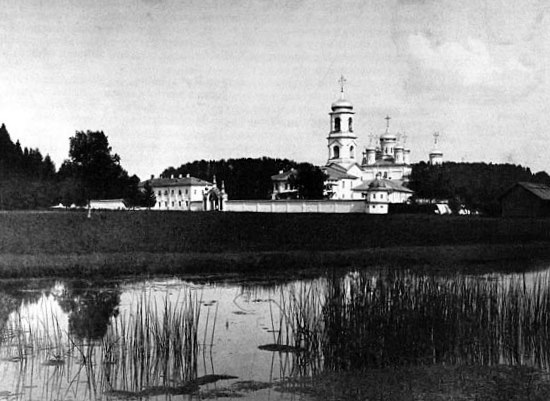
The Monastery of St. Paul of Obnora in the 18th c.
The situation changed sharply when Abbot Joasaph Tikhonov (1861-1877) was appointed father superior of the monastery. He came from a merchant family of the town of Tambov and possessed inexhaustible energy. The revival of St. Paul's Monastery became the cause of his life. Having received from his predecessor an empty treasury and semi-ruined buildings, Abbot Joasaph spent more than 200,000 rubles on construction and restoration work in the monastery. Almost all the money was received from the local and Kostroma merchants as donations.
In the time of Abbot Joasaph, the road leading from the highway to the monastery was graded; a guesthouse for wealthy pilgrims and a separate house for their servants were built. A special drain was dug out for the Nurma River flowing right at the walls of the monastery and its dry bed was used for the kitchen-garden. A new three-meter high stone wall with three octagonal towers and two gates was erected around the monastery. Under the southern part of the wall there was a basement with brick arches, which is extant. By the abbot's order a fir- and pine-tree grove was planted on the steep bank of the Nurma.
For himself the abbot built a cell deep in the woods, away from the monastery. Beside it he dug out a pond and dug a small kitchen-garden. For his cell he chose a historic place—near a big stone at which, according to a tradition, St. Paul of Obnora had spoken to St. Sergius of the Nurma.
Abbot
Joasaph had a project to create a kind of a
"memorial" near his monastery dedicated to
Christ's Passions. With this purpose an artificial
mound was piled up to the west of the monastery,
looking like a truncated cone and called the
Golgotha. On the top of this mound an octagonal
wooden chapel was erected with a huge Holy Cross and
the images of the Theotokos and Apostle St. John the
Theologian inside it.
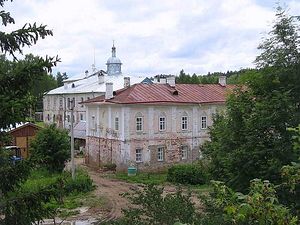
The St. Paul of Obnora Monastery today.
However, the chapel was only a temporary construction. According to the abbot's project, a grand church was to be built in its place with altars dedicated to the main events of the last days of the earthly life of Jesus Christ. The walls of the church were to be made of glass and protected by a wire netting which would make it possible to watch the divine services both from the inside and outside of the church. The upper part of the building was to be light, constructed of wooden blocks.
More realistic and thus more successful was the second project of Abbot Joasaph. He decided to build a skete near the monastery. This ancient form of monastic life took its name from the Sketis hermitage near Alexandria, Egypt, where in the 4th century lived the well-known anchorite, St. Macarius the Great. Only monks of the strongest spirit could live in sketes. In Russia preference was always given to large monastic communities—coenobiums. However, by the middle of the 14th century many big monasteries had sketes where schemamonks and elders lived. By the end of the 19th century, the sketes of the Optina, Sarov, Valaam, and Solovki monasteries were very famous.
An artificial mound, located a hundred meters east of the monastery, became the foundation for the skete of the Monastery of St. Paul of Obnora. According to tradition, it was there that St. Paul, the founder of the monastery, saw a miraculous light that marked the holy place. In 1867–1869 on the top of the mound Abbot Joasaph built a two-storey Church of the Resurrection of Christ, which has remained till our days. The lower floor was to house cells of the monks living in the skete, and the upper floor would house the main church.
A serious illness forced Abbot Joasaph to retire in November 1877, and the construction work in St. Paul's Monastery basically stopped. The only building erected after his withdrawal was a belfry. It was built in 1881–1887 in the form of a four-tier pillar crowned with a onion dome. The lower tiers of the belfry at the western wall of the refectory still exist.
The life of St. Paul's Monastery in the late 19th–early 20th century was more or less uneventful. In the summer of 1909 the monastery fell victim to a terrible fire. The fire destroyed a silver reliquary made at the order of Abbot Joasaph for the holy relics of St. Paul of Obnora.
The means for the restoration of the monastery were being collected from all over Russia.
Tsar Nicholas II donated a new reliquary for the relics of St. Paul of Obnora. In the summer of 1912, restoration work to rectify the consequences of the fire was completed. In connection with this, the monastery was visited by Grand Princess Elizabeth Fyodorovna, the widow of Grand Prince Sergei Alexandrovich, the Moscow Governor-General assassinated by the socialist revolutionaries. After the death of her husband, the Grand Princess took monastic vows. The boundless Christian charity of the Grand Princess and her martyr's death at the hands of the Bolsheviks in 1918 were not left uncrowned: in 1992, Grand Princess Elizabeth was canonized by the Russian Orthodox Church.
St. Cornelius of Komel.
Several
more kilometers up the Nurma River, we find ourselves
in the monastery of St. Cornelius of Komel
(1455-1537), one of the most distinguished successors
of the cause of St. Sergius of Radonezh—the
cause of the spread of high spirituality in Russian
monasteries. Like Abba Sergius, St. Cornelius came
from the Rostov aristocracy. Having resigned from his
service at the court of the Moscow Prince he made up
his mind to follow the words of the
Savior:If thou wilt be perfect, go
and sell that thou hast, and give to the poor, and
thou shalt have treasure in heaven: and come and
follow Me. (Mt. 19:21). Soon he took his
monastic vows in the Monastery of St. Cyril of White
Lake (Beloe Ozero)a true monastic
“academy” of that time. There St.
Cornelius labored at copying church books, an
occupation which he never gave up for the rest of his
life.
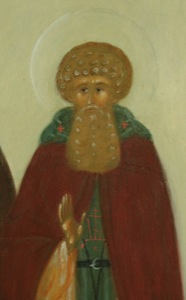
St. Cornelius of Komel.
The copying of books was for St. Cornelius not just an obedience, but his work for the benefit of the monastery. With joy he became absorbed in the spiritual depths of the Holy Scripture, thinking over every written word. Having come to St. Cyril’s Monastery together with his uncle Lukian, Monk Cornelius several years later persuaded his brother Acinthius to settle in the monastery as well. As time went by, however, a well-ordered life within a circle of people related to him by blood and spirit became a burden to Monk Cornelius. He felt he was strong enough for more severe asceticism. Having left White Lake, the zealot wandered about Russia in search of true sanctity. He lived in the lands of Novgorod and of Tver, and lived as a recluse in hermitages deep in the woods. A well-known ascetic, Archbishop Gennadius of Novgorod, became inspired with brotherly love for Monk Cornelius and offered to ordain him priest. However, the humble monk considered himself unworthy of the offer, although he was ordained many years later by Metropolitan Simon.
In around 1497, Monk Cornelius returned to Vologda and settled in the boundless and uninhabited Komel Forest, which spread to the south of Vologda. The forest was named after the Komel River. His first home was a wooden hut left by brigands. With time, news spread of the zealot living in the woods, and monks yearning for a lofty spiritual life under the guidance of a wise elder began to come to that place. In 1501, a wooden Church of the Entrance of the Blessed Virgin into the Temple was consecrated in the hermitage where Monk Cornelius sought salvation. The dedication of the church was not a chance one: all the disciples of Sts. Sergius and Cyril had a special veneration for the Most Holy Mother of God.
St.
Cornelius became famous outside of the local monastic
community. He acquired numerous spiritual children.
In 1515, by the order of Metropolitan Varlaam a stone
cathedral was erected in St. Cornelius’s
hermitage, and several years later a refectory
and a church in the name of St. Antony the
Great—one of the founders of Christian
monasticism—were built there. In order to
firmly establish the principles of high spirituality
among the brethren forever, St. Cornelius wrote his
famous Rules. The Rules in particular demanded of the
brethren absolute dispassionateness, and laid a
categorical ban on intoxicating drink for
them.
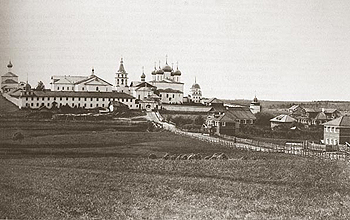
The Monastery of St. Cornelius of Komel. Photo early 20th c.
During the last years of his life, St. Cornelius lived in his cell on the bank of the Nurma River, having handed his abbot’s staff over to his favorite disciple, Monk Laurence. He spent nearly all his time in his cell, in prayer and thoughts about the future of the monastery. Like many of the founders, he was mostly concerned about the future of his cause. In the last portion of his Rules, Cornelius noted with bitterness: “I have heard many of my brethren say: ‘Now Cornelius forbids us to live according to our own free will, and when he dies we shall come to our monastery and live according to our own will’.”
When he went to his rest in the heavenly mansions, the elder lived on in the deeds and thoughts of his disciples. And they were many. Like the Gospel “birds of the air” they scattered about the northern forests of the Volga lands, nesting in monasteries they built here and there. One of them, Monk Nathaniel, wrote the Life of St. Cornelius.
In 1600, Tsar Boris Godunov ordered the veneration of elder Cornelius as a saint not only in the land of Vologda, but also “throughout Great Russia”. He sent the monastery a precious cross which was placed on the saint’s reliquary. Along with St. Cornelius’s priestly vestments and hair-shirt, the cross became the main shrine of the monastery.
The glorification of St. Cornelius promoted the construction of new stone buildings in the monastery. Near the Cathedral of the Entry of the Blessed Virgin into the Temple, restored after a great fire of 1552, there arose a four-tiered stone belfry with a hipped roof (1599–1604). A massive arched gallery connected the cathedral with the refectory. In the early 17th century, one more stone church was erected in the monastery—the Church the Resurrection of Christ. With time the monastery became one of the largest ones in the Vologda Region. From 1693 till 1764 the father superior of St. Cornelius’s Monastery had the rank of archimandrite.
Having in 1764 lost all its lands with the male serfs alone numbering more than 3 thousand, the monastery faced serious economic problems. “The churches of the monastery are rather poor,” noted a traveler who visited the monastery in 1850. The monastery received a small income from the mineral water well opened at its wall in 1765. In the middle of the 19th century, a clinic was built there where patients could take cold and warm mineral water baths for payment.
Today
St. Cornelius’s Monastery is a sorry sight.
First, as early as in the 1920s, the cathedral was
ruined, and then Communist barbarians destroyed
the wall, the brethren’s cells, the belfry, the
smaller churches, and the administrative buildings.
Only the refectory with the adjoining
cellarer’s and abbot’s chambers has
miraculously remained.
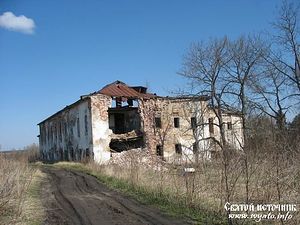
The Monastery of St. Cornelius of Komel today.
Valuable objects of art collected by the monastery over the course of centuries disappeared. Only some of them are now kept in the Vologda museum: four icons of the festal tier (16th century), epitaphion (symbolic burial Shroud of the Lord) dating from 1594, and other articles of church art.
The Nurma flows as slowly as it did five centuries ago between banks overgrown with sedge and willows. In autumn, old monastery birches growing in two uneven rows along the path leading up the slope shed their small, yellow leaves into its quiet waters. Ploughed fields lie around. The dense forest that used to give St. Cornelius the longed-for silence is no more. But the land keeps the memory of the saintly man who used to walk its paths, built his first church here, suffered hunger and privations, pleading with the Lord to send peace to Holy Russia.
The ancient monastery arouses mixed feelings. The stern grandeur of the thick refectory walls that lived through the Time of Troubles and the reign of the first Romanovs capture one’s imagination. But today’s view ruins all historical pictures created by it. How senselessly and cruelly we do away with our history! How indifferent we are to the shrines, venerated by many generations of our predecessors! It was not long ago that local residents could show St. Cornelius’s tomb in the tall weeds that grow in the place where the cathedral used to rise. Today it can be found no more…
And how many tragedies have these walls seen in recent decades! The monastery was closed down by the authorities in the 1920, and has seen numerous inhabitants since then. First it was used as a sanatorium of the Arkhangelsk Forestry Union. In 1939 the monastery housed Polish military internees. During the war they were sent to Iran where General Anders’s army was being formed. German prisoners of war were brought to the deserted monastery, succeeded by Soviet prisoners. At last the prison was closed down and a regional mental hospital was opened there instead. Can we hope that this is the last dark page in the modern history of St. Cornelius’s Monastery, that the barbaric attitude towards our monuments of history and culture will give place to respect towards the past, characteristic of a civilized society?
It is a purely rhetorical question though. Our people can value beauty and take care of it. Every old local resident remembers how it used to be beautiful in the monastery and feels sorry for the ruined old churches and for the way we Russians deal with our spiritual riches. Actually, everything is clear to them. Today nobody insists upon pulling down and blowing up churches as hotbeds of “obscurantism”. The militant atheism has quietly passed away, the dogmatic Marxism that produced it is fading away. The society is now getting to know the normal system of values, common to all mankind. The Church is again ready to use its influence to restore the moral foundations of statehood. In a word, everything is returning full cycle. And it is poverty alone that prevents people from taking immediate measures to save perishing treasures of art. Of course, it is a small consolation for the one who sees the desecrated, semi-ruined churches which may not live till better times. Nevertheless, let us try to see things in a different way.
The old Obnora Road…
Where does it lead to: to the past or to the future?
Klyuchevsky was absolutely right when he noted that numerous monks came to monasteries during the time of Russia’s ascent, when it was gathering its spiritual forces, and not during times of decline. Hard times in the “world” were always destructive for monasticism. Much earlier, before Klyuchevsky, this very idea was expressed by St. Ignatius Bryanchaninov.
Will the ancient monasteries on the Obnora and throughout the whole of Great Russia return to life? Or does soulless “museumification”—a special form of extermination, await them? Nothing seems to be easier: the monasteries should be returned to the Church for her to revive them. However, today the Church is not entirely capable of restoring everything that the state (at the time still unrepentant of its sins) suddenly decided to return to her. Besides, the formal act of reopening a monastery does not yet mean its revival as a center of spiritual enlightenment. It is only the first, and not the hardest, step towards it.
Holy Russia, as a spiritual phenomenon, as a factor of rebirth, was built first and foremost upon the foundation of ascetic labor of self-denial. Sts. Sergius of the Nurma, Gennadius of Lyubim, Paul of Obnora, Cornelius of Komel, Sylvester of Obnora were great builders of Holy Russia. They followed the path they had found and were ready to give their lives for the sake of their faith. So let us follow them along the forgotten Obnora Road, remembering the words of St. John Climacus: “Springs do not stop streaming even when there is no one who thirsts…”
From The Journal of the Moscow Patriarchate, No. 3, 1993.
N. Borisov
Edited by OrthoChristian.com
* * *
From the editor: The Obnora monasteries today.
The Holy Resurrection Monastery of St. Sylvester of Obnora has been returned to the Church, and restoration work is under way. Services are held in the church. The St. Gennadius Monastery of the Transfiguration of the Savior was returned to the Church in 1997, and the brotherhood is in the process of restoring it, although they are as yet unable to live there. The St. Sergius of Nurma Monastery of the Savior is also being restored. The Holy Trinity-St. Paul of Obnora Monastery has also been resettled by monks, and a wooden chapel now stands on the place of the destroyed church of Sts. Paul of Obnora and Sergius of Radonezh. The monastery complex is being restored. The Monastery of St. Cornelius of Komel is still in ruins.
